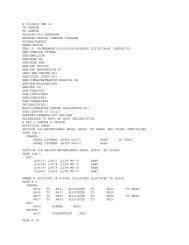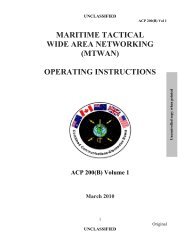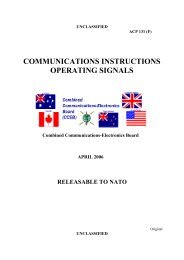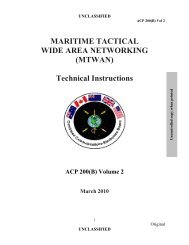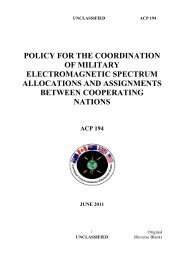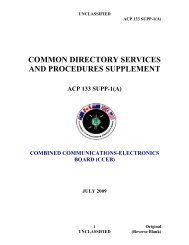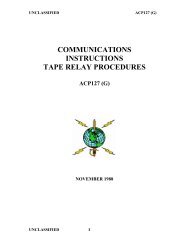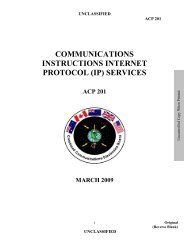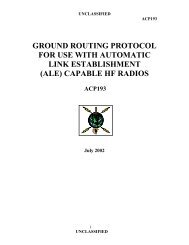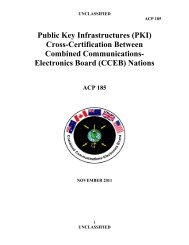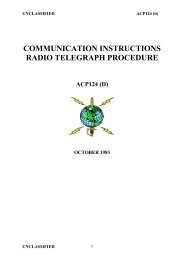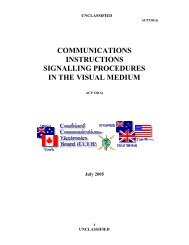ACP 137
ACP 137
ACP 137
Create successful ePaper yourself
Turn your PDF publications into a flip-book with our unique Google optimized e-Paper software.
UNCLASSIFIED<br />
<strong>ACP</strong> <strong>137</strong><br />
the first segment), a Highest Segment Sequence Number and a Hash Value for the complete<br />
Data set (the latter two being mandatory for the first segment, optional for others).<br />
452. Segmented data files (other than the first) will not contain a heading since this would<br />
make it impossible to reconstitute the file exactly on receipt, and thus would invalidate the<br />
complete file checksum.<br />
453. Experience with certain Griffin gateways has indicated that additional End of Line<br />
(i.e. CR/LF combinations) may be added unless a text attachment terminates in an End of Line<br />
sequence, which causes checksum checking to fail. In light of these discoveries, it is required<br />
that segmenting only occurs at the end of a line when sending text files. Implementations<br />
should preferably truncate files on the line before the segment size if reached, although<br />
receiving nations should cope with slightly more. Implementations should also ensure that<br />
segment sizes slightly larger than the agreed and configured limit should be supported on<br />
receipt to cater for the case where segmentation occurs at the line immediately following the<br />
maximum segmentation size (since LDIF lines are typically 80 characters or less, an increased<br />
allowance up to say 100 characters should be adequate).<br />
454. It should be noted that while segmented messages should be sent in ascending<br />
sequence, they may not be received in the same order, since the underlying messaging systems<br />
cannot guarantee order of delivery. The precedence of messages is for bilateral agreement<br />
between nations, but may be dependent upon message size, urgency etc.<br />
DATA FILE FORMATS<br />
455. Replicated data will initially be sent using the LDIF data file format [Ref. 3].<br />
However, it is envisaged that in the future, other data file formats may be allowed, although<br />
these have not yet been defined. It is appropriate therefore to incorporate a mechanism to<br />
allow the format of a data file to be specified by the sending nation for use by the receiving<br />
nation. It is the responsibility of the receiving nation to accept all supported formats.<br />
456. The format of data file transmitted may be specified by the optional keyword format<br />
within the Control Information in the message body text, followed by a keyword specifying<br />
the format of the data file. The only value currently allowable is LDIF (which may be<br />
specified). If the keyword is not present, the default of LDIF is assumed.<br />
COMPRESSION FORMATS<br />
457. The use of compressed data, is allowed by some nations, dependent upon security and<br />
networking constraints. Compressed data would greatly reduce the amount of network traffic<br />
in transferring large data files. An optional keyword compression is allowed in the Control<br />
Information to specify that compression is being used. Allowable values are currently<br />
restricted to NONE indicating no compression is present or ZIP indicating use of Zip file<br />
compression. If the keyword is not present, the default of NONE is assumed.<br />
458. Where data is compressed, the compression should be performed on the complete set<br />
of data before segmentation. Where segmentation is also required, each segment comprises a<br />
4-11<br />
Original<br />
UNCLASSIFIED



